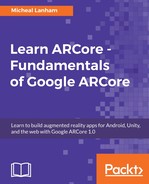Chapter 1, Getting Started, covers the fundamental concepts any modern AR app needs to tackle in order to provide a great experience to the user. We will learn the basic concepts of motion tracking, environmental understanding, and light estimation.
Chapter 2, ARCore on Android, is an introduction to Android development with Android Studio, where we show you how to install Android Studio and set up your first ARCore app.
Chapter 3, ARCore on Unity, discusses how to install and build an ARCore app with Unity. This chapter also shows you how to remotely debug an app using the Android development tools.
Chapter 4, ARCore on the Web, jumps into web development with JavaScript and focuses on how to set up your own simple web server with Node.js. Then, this chapter looks through the various sample ARCore templates and discusses how to extend those for further development.
Chapter 5, Real-World Motion Tracking, extends our learnings from the preceding chapter and extend one of the web examples to add a real-world motion tracking. Not only will this showcase several fundamentals of working with 3D concepts, but it will also demonstrate how ARCore tracks a user's motion.
Chapter 6, Understanding the Environment, jumps back to the Android platform and deal with how ARCore understands the user's environment. We will grasp how ARCore identifies planes or surfaces in the environment and meshes them for user interaction and visualization. Here, we will take a look at how to modify a shader in order to measure and colorize the points from the user.
Chapter 7, Light Estimation, explains the role that lighting and shadows play in selling the AR experience to the user. We learn how ARCore provides for the estimation of light and how it is used to light the virtual models placed by the user into the AR world.
Chapter 8, Recognizing the Environment, is where we cover the basics of Machine Learning and how essential is the technology to the success of the AR revolution. We then look to building a simple neural network that learns through supervised training using a technique called back propagation. After learning the basics of NN and deep learning, we look to a more complex example that demonstrates various forms of Machine Learning.
Chapter 9, Blending Light for Architectural Design, covers the building of an AR design app that allows the user to place virtual furniture in the living space or wherever they need to. We also cover how to place and move an object in AR using touch and how to identify when an object is selected. Then, we will extend our lighting and shadows from Chapter 7, Light Estimation and provide real-time shadows on the virtual objects.
Chapter 10, Mixing in Mixed Reality, is where we introduce mixed reality through the use of inexpensive MR headsets. ARCore is ideally suited for use in these inexpensive headsets since it already tracks the user and monitors their environment internally. We will oversee how to turn our app from a traditional mapping app using the 3D WRLD API for Unity to an AR mapping app, where we will also provide an option to switch to MR and an MR headset.
Chapter 11, Performance Tips and Troubleshooting, covers techniques for measuring an app's performance on all the development platforms we deal with. We then talk about the importance of performance and the impact it can have to the various systems. After that, we cover general debugging and troubleshooting tips, where we finish off with a table that covers the most common errors a user may encounter in this book.
